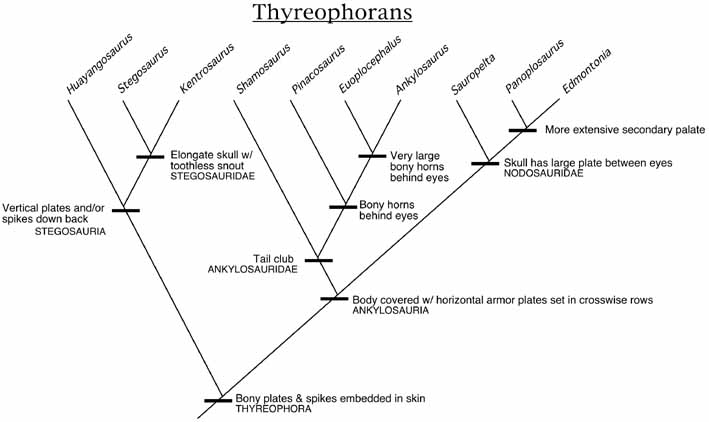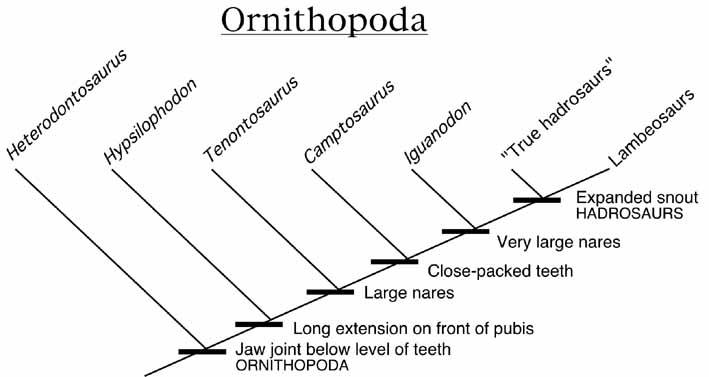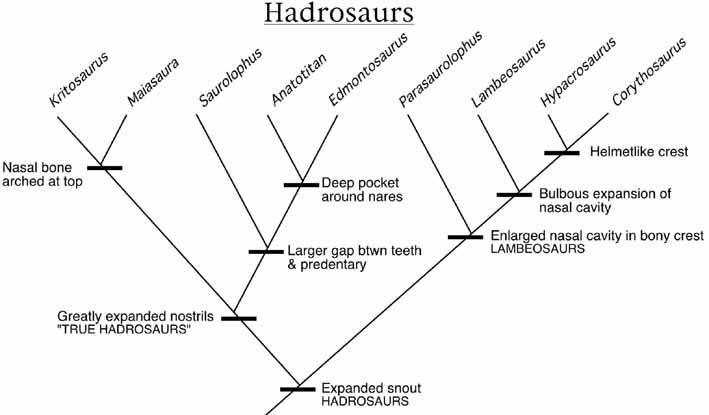
Lab # 7 - ORNITHISCHIAN DINOSAURS
(AMNH)
Introduction to the AMNH labs
The dinosaur halls at the AMNH are arranged cladistically. The purpose
of Labs 7 - 10 is to identify the synapomorphic and autapomorphic characters
for the various genera on display. Navigate your way around the exhibits
using the AMNH book (by Dingus), and use Lucas and last weekÝs lab handouts
as a guide to the anatomy. You need to go into considerably more detail
in this lab than in the general class trip, but keep it clear and relatively
simple.
There will be no formal weekly lab meeting for these labs. These labs
will be due at the end of the semester; however it is strongly suggested
that you discuss your work with the TAs between now and the end of semester.
Do not put off doing these labs until the last week; they are VERY time-consuming!
Lab 6Ýs cladogram provides the relationships between the various groups
of dinosaurs we are going to look at. The cladograms provided in this and
the following labs follow the AMNH classification; this will sometimes
be different to what we learn in class. For the purpose of the labs, follow
the AMNH classification; for the exams however you only need to learn the
classification given in lectures.
The basic instructions and format are the same for each lab. They are
given in detail below; you may need to refer back to this lab for the complete
instructions.
PART I
In this part we will look at the Thyreophora and Marginocephalia; cladograms
are provided below for these groups. These cladograms are also in the exhibits.
For each of the 2 cladograms:
-
Identify the synapomorphies on the cladogram (remember, there is one at
each branching point, so there will be several on each cladogram).
-
Draw this character as it is found in one taxon that contains it
(i.e. if the character is found in 3 taxa, just draw it for one taxon,
preferably
the least-evolved taxon). You only need to draw the character, NOT
the whole dinosaur!
-
What are the functional uses (what did the animal use this feature
for) and ecological implications (what does this say about the animalÝs
environment) of these characters?
-
Identify the autapomorphies (unique derived characters) for each
taxon on the cladogram. A few are given in the text at each display &
a few are in Lucas; the rest you will have to figure out for yourself by
comparing with the other displays.
-
Draw the autapomorphies for each taxon (again, you do not need
to draw the whole dinosaur!)
-
Place these unique derived characters in their functional andecological
context.
-
Compare the appearance in time of each taxon with their position on the
cladogram. Are any apparently out of order?

In this second part we will look at the Ornithopoda (= Euornithopoda
of AMNH). Cladograms are provided for the ornithopods and hadrosaurs. These
cladograms are also in the exhibits.
For each of the 2 cladograms:
-
Identify the synapomorphies on the cladogram.
-
Draw this character as it is found in one taxon that contains it.
-
Place these shared derived characters in their functional and ecological
context.
-
Identify the autapomorphies (unique derived characters) for each taxon
on the cladogram.
-
Draw the autapomorphies for each taxon.
-
Place these unique derived characters in their functional and ecological
context.
-
Compare the appearance in time of each taxon with their position on the
cladogram. Are any apparently out of order?






